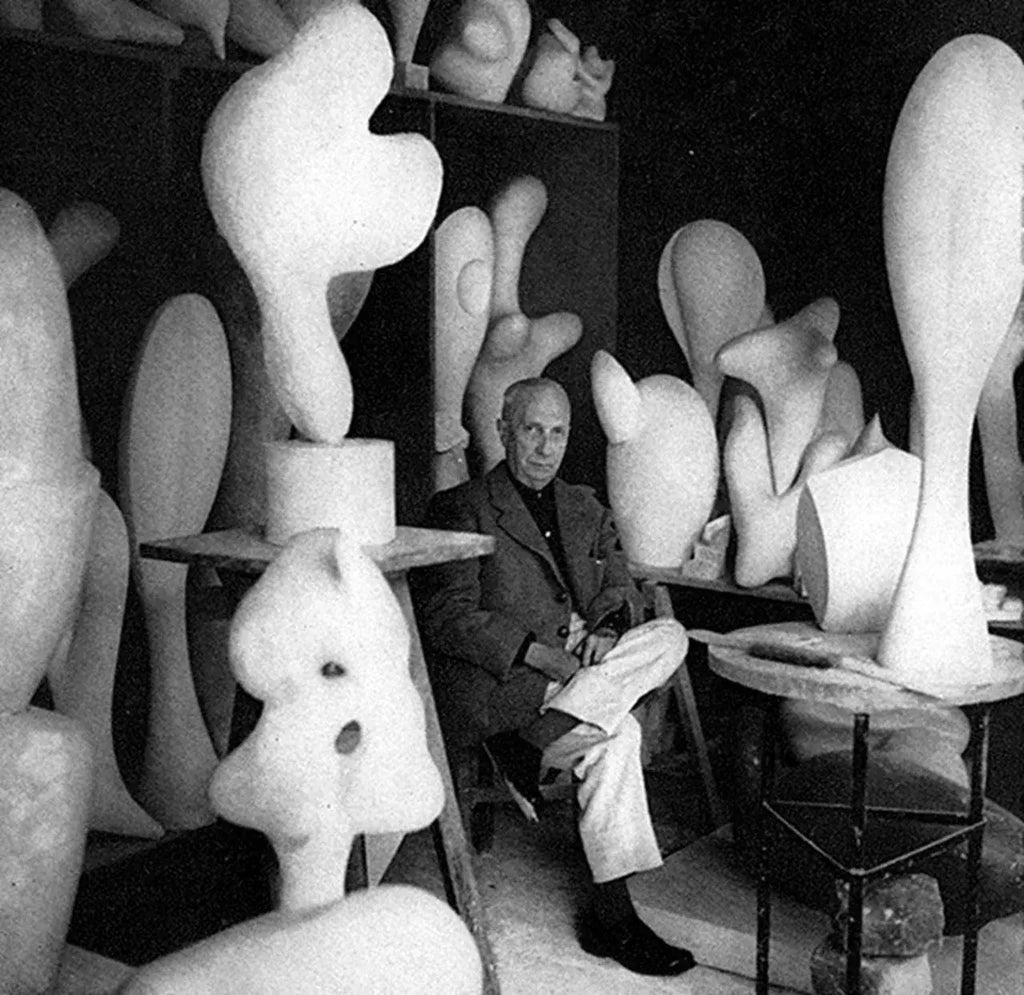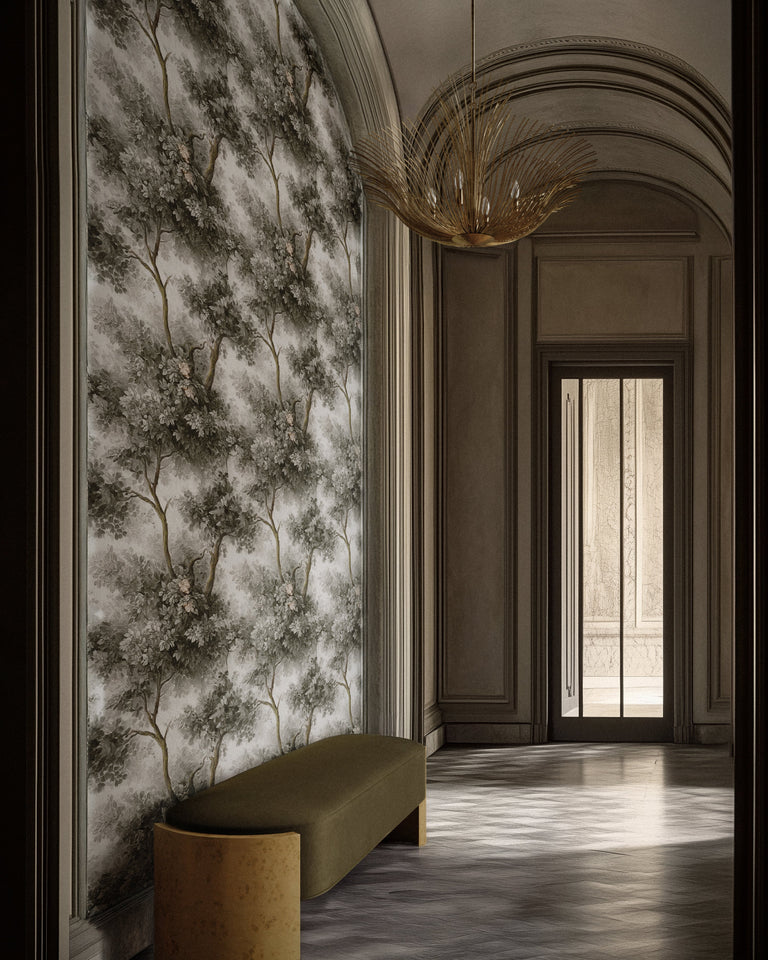
Plaster's Clever Play: How Arp and Hepworth Redefined Home Decor
In the realm of home decor, few materials have undergone as dramatic a transformation as humble plaster. Once relegated to construction sites and medical offices, plaster found its artistic voice in the hands of two revolutionary modernist masters: Jean Arp and Barbara Hepworth. These visionary sculptors didn't simply use plaster—they liberated it, revealing its potential to create forms that seem to breathe with organic life while bringing museum-quality artistry into intimate domestic spaces.
The Alchemist of Organic Abstraction: Jean Arp's Plaster Revolution
Jean Arp usually created his sculptures in plaster, sanding away until he found the satisfying shape, and thought up the titles only when the work was complete. This intuitive approach to plaster working represented a radical departure from traditional sculptural methods. While other artists used plaster merely as a stepping stone to bronze or marble, Arp recognized plaster's unique qualities as a final artistic medium.
Born in 1886 in the contested region of Strasbourg, Arp's approach to form, often referred to as organic abstraction, was remarkably consistent: his wavy lines suggested plants, body parts and other natural motifs, while remaining entirely abstract. His genius lay in understanding that plaster could capture something that more precious materials couldn't—the sense of forms still in the process of becoming, shapes that seemed to emerge from some primordial creative force.

Photo courtesy of SFMoma, Jean Arp
The Material Philosophy: Why Plaster Mattered
Arp began sculpting in the round in the 1930s, developing the enigmatic and amorphous natural forms in plaster, bronze and marble for which he is best known. But it was his relationship with plaster that proved most revolutionary for home decor applications. Unlike the permanence of bronze or the preciousness of marble, plaster possessed an essential humility that made it perfect for domestic environments.
Plaster allowed Arp to create what he called "constellations"—simple "constellations" of forms, which suggest the play of both cells and heavenly bodies. These pieces brought cosmic wonder into intimate spaces, transforming living rooms and bedrooms into contemplative environments where the boundaries between interior and universe seemed to dissolve.

Photo courtesy of Christies, Jean Arp
The Dadaist Spirit in Domestic Space
As a founding member of the Dada movement, Arp's abstract collages, paintings, and sculptures of organic forms were motivated by an interest in harnessing unconscious thought and parodying established ideas. This rebellious spirit translated perfectly to home decor, where his plaster sculptures challenged conventional notions of what belonged in domestic spaces.
"A painting or sculpture not modeled on any real object is every bit as concrete and sensuous as a leaf or a stone," he once remarked. "But it is an incomplete art which privileges the intellect to the detriment of the senses." This philosophy made his plaster works ideal for homes—they engaged both mind and body, inviting touch and contemplation in ways that traditional decorative objects simply couldn't match.
Barbara Hepworth: Plaster as Architectural Poetry
While Arp explored plaster's organic possibilities, Barbara Hepworth brought architectural sensibility to the medium. Hepworth's uncle was a General Practitioner, and he provided her with plaster that he used as casts for broken bones dating back to the first decades of the century, including some of her first sculptures and then continuing on throughout her career for its utility for model-making as well as fully-formed sculptural works in themselves.
This humble beginning with medical plaster would prove prophetic. Hepworth understood that plaster's association with healing and restoration made it particularly appropriate for domestic environments—spaces dedicated to renewal and regeneration.

Photo courtesy of The Hepworth Wakefield, Barbara Hepworth 1961
The Revolutionary Pierce: Opening Space in Home Decor
In the early 1930s, Hepworth separated from Skeaping and "pierced" a sculpture for the first time—Pierced Form (1932). This breakthrough would revolutionize not just sculpture but sculptural home decor. Throughout her career, Barbara Hepworth made sculptures with gaping voids, eliciting tensions between presence and absence and the interplay of art and life.
For home decor applications, this concept of "pierced" forms proved revolutionary. Sculptural objects no longer needed to be solid presences that competed with furniture and architecture. Instead, they could create dialogue with their surroundings, allowing light and space to flow through them while maintaining powerful visual impact.

Photo courtesy of Tate
The Technique of Organic Flow
By building up plaster on a metal armature, Hepworth was able to create flowing forms, perhaps to retain what she described as 'the qualities of molten material'. This technique allowed her to create objects that seemed to capture movement itself—perfect for home environments where the play of light and shadow throughout the day could animate static forms.
The rough sheen of the work's surface holds out hints of natural formations, while the form itself allows particularly open glimpses through the sculpture to the setting beyond, combining Hepworth's continually development achievements of combining materials and absence to make forms that both speak of nature while distilling essences of underlying organic shapes.

Photo courtesy of Tate
The Philosophy of Presence and Absence
"I do not like drama in sculpture. To me, drama has its fulfillment in time and space - not in being arrested in concrete material. I want to achieve a 'presence' in my sculptures of such a kind that they remain true and valid in all moods", Hepworth explained. This philosophy made her plaster works ideal for home environments, where objects needed to enhance rather than dominate daily life.
Her understanding that Hepworth investigated absence/presence in sculpture and played with the relationship of her sculptural forms to the larger spaces surrounding them proved crucial for domestic applications. Her pieces didn't compete with furniture or architecture but rather enhanced the spatial relationships that make homes feel harmonious and complete.
The Democratic Medium: Plaster's Accessibility
Both Arp and Hepworth recognized that plaster's relative affordability and workability made sophisticated sculptural forms accessible beyond the realm of major collectors and museums. This democratic aspect of plaster aligned perfectly with modernist ideals of bringing good design into everyday life.
The sculptor was adventurous with her materials. Throughout her career—during which she made an estimated 500 sculptures—Hepworth worked with gray alabaster, Serravezza marble, silver, Burmese wood, limestone, and bronze. Yet she consistently returned to plaster for its unique ability to capture the essence of organic form without the intimidation factor of precious materials.

Photo courtesy of Christies, Jean Arp in the Studio
Contemporary Applications: The Legacy Lives On
The innovations of Arp and Hepworth continue to influence contemporary home decor, where plaster has experienced a remarkable renaissance. Modern makers are rediscovering plaster's unique properties—its ability to capture subtle surface variations, its responsiveness to light, and its capacity for creating forms that feel both ancient and utterly contemporary.
The organic forms pioneered by these masters prove particularly relevant in today's homes, where people seek objects that provide visual and emotional relief from the hard edges and digital interfaces that dominate modern life.

Photo courtesy of Lemieux et Cie, includes Lucien Table Base, Carmen Table Top, Souple Chair, Malus Object, and Matili Bowl
The Science of Organic Response
Contemporary research in neuroaesthetics supports what Arp and Hepworth intuited about organic forms. Studies show that curved, flowing shapes trigger positive psychological responses, reducing stress and promoting the kind of mental restoration that makes homes true sanctuaries.
The organic abstraction that both artists championed creates what researchers call "soft fascination"—the gentle mental engagement that allows for both focused attention and relaxed contemplation. This makes their aesthetic approach particularly valuable for contemporary home environments.

Photo courtesy of Lemieux et Cie, includes Aurelie Chair, Souple Console, Petal Kyoto Art, Jardin Jaipur Art, and Cheverny Sconce.
A Modernist Legacy for Contemporary Homes
Our Plaster collection represents a direct continuation of the revolutionary vision established by Arp and Hepworth. From lighting to cocktail tables, each piece features the asymmetrical organic curves and hand-sculpted quality that made these masters so influential, while incorporating contemporary understanding of how sculptural objects enhance domestic life.

Photo courtesy of Lemieux et Cie, includes Souple Console, Cornet Chandelier, and Colbert Vases
The Future of Sculptural Home Decor
As our homes become increasingly important as sanctuaries from digital overwhelm, the need for objects that provide genuine visual and emotional restoration has never been greater. The organic abstraction pioneered by Arp and Hepworth offers a timeless solution—forms that connect us to natural rhythms while serving the practical needs of contemporary life.
These pieces prove that the most sophisticated home decor doesn't announce itself through price or pedigree but through its ability to enhance daily experience. Like the best works of Arp and Hepworth, they become partners in the essential human project of creating environments that nourish both body and soul.

Photo courtesy of Lemieux et Cie, includes Souple Console, Letang Artwork, Bretagne Vase
In honoring the revolutionary vision of these modernist masters, we continue their essential insight: that the most beautiful objects don't simply decorate spaces—they transform them into places where life itself becomes more beautiful.
Discover our plaster collection, where the organic abstraction of Arp and Hepworth meets contemporary home living. Each piece represents our commitment to sculptural objects that honor design history while serving the needs of modern life.
Recent Edits



